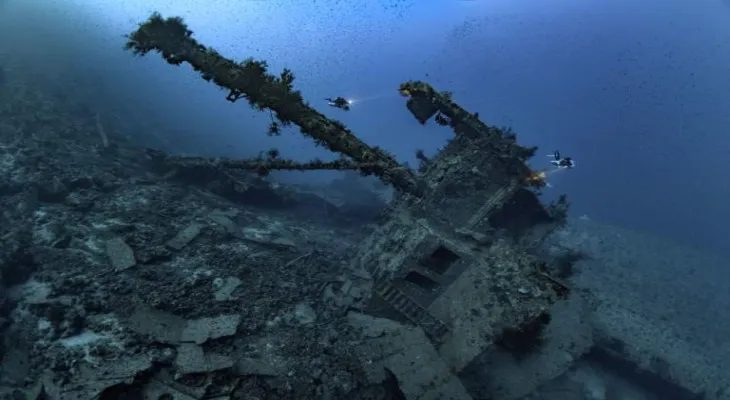Search here
Newspaper
Search here

Arab Canada News
News

Published: February 16, 2024
A mysterious shipwreck suddenly appeared on the shores of a coastal community on the island of “Newfoundland” in Canada last month, and it is believed that a severe storm lifted it from the seabed. As a new storm heads toward the eastern part of the country, the community is racing against time to save the wreckage.
One of the locals discovered the wreck in the shallow waters near the small town of Cape Ray on the morning of January 20th.
As soon as Sean Bath and Trevor Croft, both from the Clean Harbours Initiative, heard about it, they brought their diving equipment and headed to the shore.
While swimming around the ship, both tried to secure it by tying ropes around its approximately 100-foot (30-meter) hull.
Croft said: “It is an extremely magical experience to be one of the first two people to stand on that ship, which is probably two hundred years old.”
Both worked in the area for two years as part of a coastal cleanup operation following Hurricane “Fiona,” which struck the Atlantic coast of Canada in 2022 and was considered one of the strongest storms in the country’s history.
Bath believes that Hurricane “Fiona” displaced the shipwreck from its original place before it slowly drifted toward the southwestern coast of Newfoundland Island, driven by storms and sea waves.
Now, with a new storm approaching, the community is striving hard to prevent the ship from being damaged by the same elements that brought it to their shores.
In this regard, experts have said that the Cape Ray shipwreck is a model of a broader phenomenon in which storms caused by climate change reveal underwater historical remains but may also destroy them.
The origins and age of the wreck are still unknown, and Croft reported that it might be a French or British ship about two hundred years old, but these are just guesses until it is brought out of the water.
Lisa Briggs, a marine archaeologist and research fellow at Cranfield University in the UK, pointed out that the wreck is important to the community because it might be evidence of how humans reached the island.
She continued: “It is likely that the people descended from those who came on this ship still live on the island today.”
However, this preserved slice of local history is at risk; the tidal movements have already weakened the ship, and although the wood is in good condition, it is fastened with copper nails.
Without government funds to extract and preserve the wreck, Bath and Croft are trying to raise money through a campaign on GoFundMe.
They set the goal to recover the wreck from the water to preserve it and eventually display it as a tourist attraction for this remote community.
Briggs said that the phenomenon of storms displacing shipwrecks from the seabed, where they sometimes rested for several centuries, is common, especially with climate change contributing to producing stronger and more intense storms.
Briggs added that climate change brings other threats to shipwrecks as well, as rising levels of carbon pollution in the atmosphere change the chemistry of seawater, making it more acidic.
This can accelerate the decomposition of finely preserved organic materials on shipwrecks, such as ropes, sails, and textiles, and there is another nightmare for underwater archaeology: shipworms, these worm-like mollusks have a huge appetite for wood.
Comments